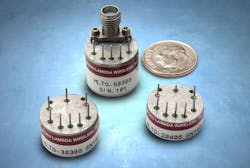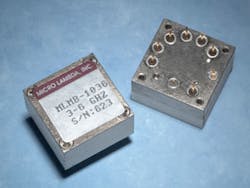Microwave oscillators based on yttrium-iron-garnet (YIG) resonators have long been prized for their low phase noise and linear tuning capabilities. The performance has always come at the cost of limited frequency-modulation (FM) 3-dB bandwidth—typically just a few MHz—which challenged synthesizer designers attempting to stabilize these sources with a phase-locked loop (PLL).
But those limits are no more: Micro Lambda Wireless, Inc. has introduced YIG oscillator technology with FM 3-dB bandwidths of 20 MHz and higher, applicable to both electromagnetic and permanent-magnet (PM) type YIG oscillators. The firm designs and manufactures PM YIG sources from 2 to 20 GHz (Fig. 1) and electromagnetic YIG oscillators (Fig. 2) from 0.5 to 40.0 GHz.
Smaller YIG oscillators, such as the TO-8-packaged MLSMO series of PM YIG oscillators and the mini and PCB lines of sources, are currently available with the wideband FM to 16 GHz. Larger oscillators, such as 1-in. and 1.25-in. cubes and 1.75-in. cylinders, will be available shortly with the wideband FM capabilities. These exceptional FM capabilities are available as options meeting specific customer requirements.
The firm’s various YIG oscillators are available for narrowband and wideband frequency tuning ranges. The MLSMO series, for example, covers a variety of frequency bands, including 3.0 to 6.0 GHz, 4.0 to 9.0 GHz, and 6.5 to 13.0 GHz. The output power for all models is +8 dBm across each frequency range, with phase noise as good as -128 dBc/Hz offset 100 kHz from carriers to 9 GHz.
The electromagnetic and PM YIG oscillators differ in their approaches to the resonant magnetic structure within each oscillator, as well as with their resulting performance levels. While both approaches are capable of linear tuning low noise, electromagnet YIG oscillators offer extended frequency coverage with wider tuning ranges than PM YIG oscillators based on a magnet tuned at the factory according to a customer’s requirements.
The PM approach yields a tuning bandwidth of typically ±2 GHz, while the electromagnet approach can achieve tuning bandwidths in excess of an octave (albeit with higher power consumption, owing to the additional power needed to energize the electromagnet).
To accomplish wideband FM with these different magnet structures, different design approaches and different FM driver configurations were required. For an end user, the results are the same, with FM tuning coils capable of 3-dB bandwidths in excess of 20 MHz and with standard FM coil sensitivity the same for the two YIG oscillator types, at 150 kHz/mA. For either type of oscillator and FM coil, the minimum frequency deviation is ±15 MHz.
To verify the wideband capabilities of the FM coils and drivers in both YIG oscillator types, swept-frequency hands-on testing was performed by Micro Lambda Vice President of Engineering Dave Suddarth and President John Nguyen. Testing was performed with the aid of a swept function generator capable of 30-MHz bandwidth, an FM discriminator, the various FM coil drivers under test, and a digital storage oscilloscope (DSO).
Test results were impressive. By way of example: Both oscillator types were studied at an RF/microwave frequency of 6.662 GHz using different five-turn FM coils in custom test fixtures. A 2-to-8-GHz TO-8 PM YIG oscillator was characterized by means of a linear FM sweep from 1 Hz to 30 MHz, exhibiting a 3-dB FM bandwidth of 28 MHz. Similarly, an electromagnet-based 3-to-8-GHz YIG oscillator was evaluated with a linear FM sweep from 1 Hz to 25 MHz, yielding a 3-dB FM bandwidth of 21 MHz.
This new wideband FM capability should make these YIG oscillators candidates for any designer seeking low phase noise but put off by the relatively narrow 3-dB FM bandwidth. The 3-dB FM bandwidth of 20 MHz or more clears the way for a wide range of applications to 40 GHz and beyond—whether in terrestrial and satellite receivers, test equipment, or military electronic systems. P&A: 4 wks. from receipt of order.
Micro Lambda Wireless, Inc., 46515 Landing Pkwy., Fremont, CA 94538; (510) 770-9221
About the Author
Jack Browne
Technical Contributor
Jack Browne, Technical Contributor, has worked in technical publishing for over 30 years. He managed the content and production of three technical journals while at the American Institute of Physics, including Medical Physics and the Journal of Vacuum Science & Technology. He has been a Publisher and Editor for Penton Media, started the firm’s Wireless Symposium & Exhibition trade show in 1993, and currently serves as Technical Contributor for that company's Microwaves & RF magazine. Browne, who holds a BS in Mathematics from City College of New York and BA degrees in English and Philosophy from Fordham University, is a member of the IEEE.



